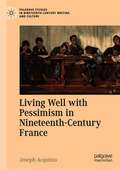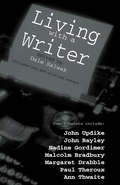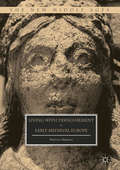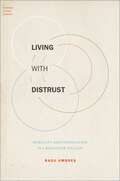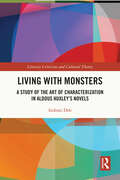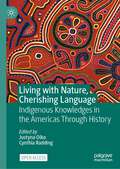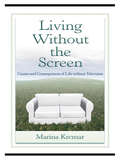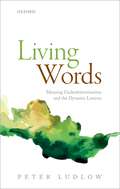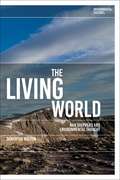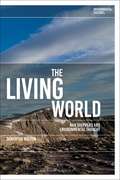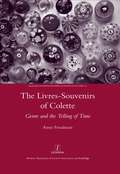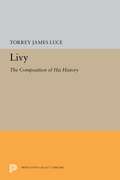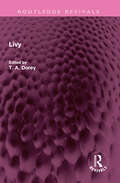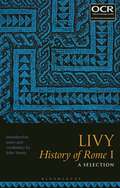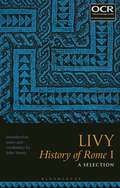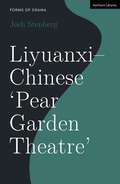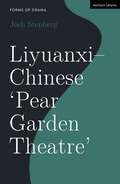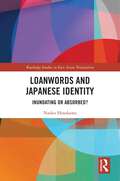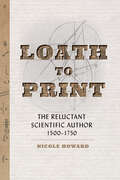- Table View
- List View
Living Well with Pessimism in Nineteenth-Century France (Palgrave Studies in Nineteenth-Century Writing and Culture)
by Joseph AcquistoThis book traces the emergence of modern pessimism in nineteenth-century France and examines its aesthetic, epistemological, ethical, and political implications. It explores how, since pessimism as a worldview is not empirically verifiable, writers on pessimism shift the discussion to verisimilitude, opening up rich territory for cross-fertilization between philosophy and literature. The book traces debates on pessimism in the nineteenth century among French nonfiction writers who either lauded its promotion of compassion or condemned it for being a sick and unliveable attempt at renunciation. It then examines the way novelists and poets take up and transform these questions by portraying characters in lived situations that serve as testing grounds for the merits or limitations of pessimism. The debate on pessimism that emerged in the nineteenth century is still very much with us, and this book offers an interhistorical argument for embracing pessimism as a way of living well in the world, aesthetically, ethically, and politically.
Living With a Writer
by D. SalwakLiving With A Writer brings together a group of prestigious contributors to discuss the writing lives of contemporary poets, novelists, critics, dramatists, editors and collaborators. What are the practical considerations of being a writer? What are the household dynamics? How do the circumstances contribute to the work? What does it tell us about the creative process? The book features pieces from well-known authors and partners in famous literary relationships, including John Bayley, Amanda Craig, Nadine Gordimer, Ann Thwaite, Paul Theroux and John Updike.
Living with Disfigurement in Early Medieval Europe (The New Middle Ages)
by Patricia SkinnerThis book is open access under a CC-BY 4.0 license. This book examines social and medical responses to the disfigured face in early medieval Europe, arguing that the study of head and facial injuries can offer a new contribution to the history of early medieval medicine and culture, as well as exploring the language of violence and social interactions. Despite the prevalence of warfare and conflict in early medieval society, and a veritable industry of medieval historians studying it, there has in fact been very little attention paid to the subject of head wounds and facial damage in the course of war and/or punitive justice. The impact of acquired disfigurement —for the individual, and for her or his family and community—is barely registered, and only recently has there been any attempt to explore the question of how damaged tissue and bone might be treated medically or surgically. In the wake of new work on disability and the emotions in the medieval period, this study documents how acquired disfigurement is recorded across different geographical and chronological contexts in the period.
Living with Distrust: Morality and Cooperation in a Romanian Village (Foundations of Human Interaction)
by Radu UmbresPeople in the Romanian village of Sateni distrust each other so much, that they would rather take a building apart than share it. Satenis think of life as struggle for scarce resources--a struggle that can lead to deception, exploitation, or predation. Cooperation with unrelated or unfamiliar partners fails while distrust permeates everyday life and cultural representations. Yet, each person engages in profound relationships with a particular set of people, expressed in cooperative actions. Living in Distrust makes sense of this worldview-one divided between strong moral relationships and deep suspicion towards the rest of the village society-through an ethnography of distrust. Drawing on two years of fieldwork, Radu Umbres offers an interdisciplinary interpretation of social interactions in a low trust society. This cognitive ethnography argues that the costs of misplaced trust made Sateni restrict their cooperative behavior to a safe set of social relationships: family, kinship, and friendship ties. Umbres explains how mutual trust appears by social agreement around culturally-codified institutions and persists only by fair cooperative interactions. Despite scarce representations or investments in the common good, the village society reproduces its low-level equilibrium of cooperation in relative stability. In an exploration of the structural influences on community morality and a defense of distrust, the book also demonstrates how investing trust in family first is an optimal strategy against ecological or political risks. By highlighting a system of dual morality sharply distinct from the Western-liberal ethos, Living with Distrust addresses perennial moral dilemmas and essential questions of secrecy and honesty, distrust and reputation.
Living with Distrust: Morality and Cooperation in a Romanian Village (Foundations of Human Interaction)
by Radu UmbresPeople in the Romanian village of Sateni distrust each other so much, that they would rather take a building apart than share it. Satenis think of life as struggle for scarce resources--a struggle that can lead to deception, exploitation, or predation. Cooperation with unrelated or unfamiliar partners fails while distrust permeates everyday life and cultural representations. Yet, each person engages in profound relationships with a particular set of people, expressed in cooperative actions. Living in Distrust makes sense of this worldview-one divided between strong moral relationships and deep suspicion towards the rest of the village society-through an ethnography of distrust. Drawing on two years of fieldwork, Radu Umbres offers an interdisciplinary interpretation of social interactions in a low trust society. This cognitive ethnography argues that the costs of misplaced trust made Sateni restrict their cooperative behavior to a safe set of social relationships: family, kinship, and friendship ties. Umbres explains how mutual trust appears by social agreement around culturally-codified institutions and persists only by fair cooperative interactions. Despite scarce representations or investments in the common good, the village society reproduces its low-level equilibrium of cooperation in relative stability. In an exploration of the structural influences on community morality and a defense of distrust, the book also demonstrates how investing trust in family first is an optimal strategy against ecological or political risks. By highlighting a system of dual morality sharply distinct from the Western-liberal ethos, Living with Distrust addresses perennial moral dilemmas and essential questions of secrecy and honesty, distrust and reputation.
Living with Monsters: A Study of the Art of Characterization in Aldous Huxley’s Novels (Literary Criticism and Cultural Theory)
by Indrani DebAldous Huxley is one of the most well-known modernist intellectuals of the first half of the twentieth century, excelling in novels, essays, philosophical tracts, and poems. His novels are special in that they use a unique form – the novel of ideas – with which to satirize human nature and the pride regarding human achievement. Few readers of English literature are not acquainted with books like Point Counter Point, Eyeless in Gaza and Brave New World (novels dealt with in detail). A proper study of Huxley’s characterization in his novels opens up a veritable treasure-house of history, philosophy, psychology, and incisive satire. "Characterology", as the art of projecting different kinds of characters is called, is an ancient art, which either aimed at representing the entire universe in a single individual, or the same in a variegated form through various individuals. Huxley uses the latter kind in his representation of character, and as such, a study of the characters of his novels opens up a general interpretation of the universe as a whole.
Living with Monsters: A Study of the Art of Characterization in Aldous Huxley’s Novels (Literary Criticism and Cultural Theory)
by Indrani DebAldous Huxley is one of the most well-known modernist intellectuals of the first half of the twentieth century, excelling in novels, essays, philosophical tracts, and poems. His novels are special in that they use a unique form – the novel of ideas – with which to satirize human nature and the pride regarding human achievement. Few readers of English literature are not acquainted with books like Point Counter Point, Eyeless in Gaza and Brave New World (novels dealt with in detail). A proper study of Huxley’s characterization in his novels opens up a veritable treasure-house of history, philosophy, psychology, and incisive satire. "Characterology", as the art of projecting different kinds of characters is called, is an ancient art, which either aimed at representing the entire universe in a single individual, or the same in a variegated form through various individuals. Huxley uses the latter kind in his representation of character, and as such, a study of the characters of his novels opens up a general interpretation of the universe as a whole.
Living with Nature, Cherishing Language: Indigenous Knowledges in the Americas Through History
by Justyna Olko Cynthia RaddingThis open access book explores the deep connections between environment, language, and cultural integrity, with a focus on Indigenous peoples from early modern times to the present. It illustrates the close integration of nature and culture through historical processes of environmental change in North, Central, and South America and the nurturing of local knowledge through ancestral languages and oral traditions. This volume fills a unique space by bringing together the issues of environment, language and cultural integrity in Latin American historical and cultural spheres. It explores the reciprocal and necessary relations between language/culture and environment; how they can lead to sustainable practices; how environmental knowledge and sustainable practices toward the environment are reflected in local languages, local sources and local socio-cultural practices. The book combines interdisciplinary methods and initiates a dialogue among scientifically trained scholars and local communities to compare their perspectives on well-being in remote and recent historical periods and it will be of interest to students and scholars in fields including sociolinguistics, (ethno)history, linguistic anthropology, cultural studies and cultural anthropology, environmental studies and Indigenous/minority studies.
Living Without the Screen: Causes and Consequences of Life without Television
by Marina KrcmarLiving Without the Screen provides an in-depth study of those American families and individuals who opt not to watch television, exploring the reasons behind their choices, discussing their beliefs about television, and examining the current role of television in the American family. Author Marina Krcmar answers several questions in the volume: What is television? Who are those people who reject it? What are their reasons for doing so? How do they believe their lives are different because of this choice? What impact does this choice have on media research? This volume provides a current, distinctive, and important look at how personal choices on media use are made, and how these choices reflect more broadly on media’s place in today’s society. A compelling exploration of the motivations and rationales for those who choose to live without television, this book is a must-read for scholars and researchers working in children and media, media literacy, sociology, family studies and related areas. It will also be of interest to anyone with questions about media usage and the choices families make regarding the role of media in their lives.
Living Without the Screen: Causes and Consequences of Life without Television
by Marina KrcmarLiving Without the Screen provides an in-depth study of those American families and individuals who opt not to watch television, exploring the reasons behind their choices, discussing their beliefs about television, and examining the current role of television in the American family. Author Marina Krcmar answers several questions in the volume: What is television? Who are those people who reject it? What are their reasons for doing so? How do they believe their lives are different because of this choice? What impact does this choice have on media research? This volume provides a current, distinctive, and important look at how personal choices on media use are made, and how these choices reflect more broadly on media’s place in today’s society. A compelling exploration of the motivations and rationales for those who choose to live without television, this book is a must-read for scholars and researchers working in children and media, media literacy, sociology, family studies and related areas. It will also be of interest to anyone with questions about media usage and the choices families make regarding the role of media in their lives.
Living Words: Meaning Underdetermination and the Dynamic Lexicon
by Peter LudlowPeter Ludlow shows how word meanings are much more dynamic than we might have supposed, and explores how meanings are modulated (changed) even during the course of our everyday conversations. When we engage with communicative partners we build micro-languages on the fly—languages that may be fleeting, but which serve our joint interests. Sometimes we sync up on word meanings without reflection, but in many cases we debate the proper modulation of the meanings of our words. Living Words explores the norms that govern the ways in which we litigate word meanings. The resulting view is radical, and Ludlow shows that it has far-reaching consequences for our political and legal discourse and also for some of the deepest and most intractable puzzles that have gripped English-language philosophy for the past 100 years—including puzzles in the foundations of semantics, epistemology, and logic.
The Living World: Nan Shepherd and Environmental Thought (Environmental Cultures)
by Samantha WaltonHarnessing new enthusiasm for Nan Shepherd's writing, The Living World asks how literature might help us reimagine humanity's place on earth in the midst of our ecological crisis. The first book to examine Shepherd's writing through an ecocritical lens, it reveals forgotten details about the scientific, political and philosophical climate of early twentieth century Scotland, and offers new insights into Shepherd's distinctive environmental thought. More than this, this book reveals how Shepherd's ways of relating to complex, interconnected ecologies predate many of the core themes and concerns of the multi-disciplinary environmental humanities, and may inform their future development.Broken down into chapters focusing on themes of place, ecology, environmentalism, Deep Time, vital matter and selfhood, The Living World offers the first integrated study of Shepherd's writing and legacy, making the work of this philosopher, feminist, amateur ecologist, geologist, and innovative modernist, accessible and relevant to a new community of readers.
The Living World: Nan Shepherd and Environmental Thought (Environmental Cultures)
by Samantha WaltonHarnessing new enthusiasm for Nan Shepherd's writing, The Living World asks how literature might help us reimagine humanity's place on earth in the midst of our ecological crisis. The first book to examine Shepherd's writing through an ecocritical lens, it reveals forgotten details about the scientific, political and philosophical climate of early twentieth century Scotland, and offers new insights into Shepherd's distinctive environmental thought. More than this, this book reveals how Shepherd's ways of relating to complex, interconnected ecologies predate many of the core themes and concerns of the multi-disciplinary environmental humanities, and may inform their future development.Broken down into chapters focusing on themes of place, ecology, environmentalism, Deep Time, vital matter and selfhood, The Living World offers the first integrated study of Shepherd's writing and legacy, making the work of this philosopher, feminist, amateur ecologist, geologist, and innovative modernist, accessible and relevant to a new community of readers.
The Livres-souvenirs of Colette: Genre and the Telling of Time
by Anne FreadmanThroughout her career, Colette experimented with genre for the purposes of telling stories of her life. The books that resulted, known collectively as her 'livres-souvenirs', are far from being autobiographies in the customary sense. By addressing the need to reconsider the generic issues surrounding autobiographical story-telling, Anne Freadman's study brings the richness of 'the genre question' to the fore, shedding a fresh light on this much-loved body of work. From the vignettes ofLa Maison de Claudineto the note-books ofL'etoile vesper andLe Fanal bleu, from stories of losing to stories of collecting, Colette's memory books take different narrative forms and explore the passing of time in different ways. This book investigates Colette's variegated generic choices as so many ways of 'telling time'.
The Livres-souvenirs of Colette: Genre and the Telling of Time
by Anne FreadmanThroughout her career, Colette experimented with genre for the purposes of telling stories of her life. The books that resulted, known collectively as her 'livres-souvenirs', are far from being autobiographies in the customary sense. By addressing the need to reconsider the generic issues surrounding autobiographical story-telling, Anne Freadman's study brings the richness of 'the genre question' to the fore, shedding a fresh light on this much-loved body of work. From the vignettes ofLa Maison de Claudineto the note-books ofL'etoile vesper andLe Fanal bleu, from stories of losing to stories of collecting, Colette's memory books take different narrative forms and explore the passing of time in different ways. This book investigates Colette's variegated generic choices as so many ways of 'telling time'.
Livy: The Composition of His History (Princeton Legacy Library #5563)
by Torrey James LuceProfessor Luce considers to what extent Livy may be said to have been in control of his historical material. What is the significance, the author asks, of the units by which Livy structured his history? How did he go about preparing himself to write, and what methods did he use in the course of actual composition? Did he have an interpretation of his own concerning the overall course of Roman history, and, if so, how did it affect his selection and arrangement of material?The author examines these questions largely by the means of an analysis of Books 31-45, which he compares with the work of Polybius. He then scrutinizes the design of the history as a whole, its author's attitude toward his srouces generally, and his method of composition. A final chapter considers how Livy's use of material may have been influenced by his view of change and development in Roman history, particularly with regard to the genesis and declince of the Roman national character. By examining LIvy's method of creation, Professor Luce extends our understanding of his achievement.T.J. Luce is Professor and Chairman of the Classics Department at Princeton University.Originally published in 1978.The Princeton Legacy Library uses the latest print-on-demand technology to again make available previously out-of-print books from the distinguished backlist of Princeton University Press. These editions preserve the original texts of these important books while presenting them in durable paperback and hardcover editions. The goal of the Princeton Legacy Library is to vastly increase access to the rich scholarly heritage found in the thousands of books published by Princeton University Press since its founding in 1905.
Livy: A Critical Description (Routledge Revivals)
by Kenneth QuinnFirst published in 1971, Livy is a collection of essays that deals with Livy’s work and its influence on the scholarship of Western Europe. The monumental nature of Livy’s History makes it a source of material for all those interested in the means by which Rome grew into an Imperial power and in the institutions that made her great. Later generations have also sought in Livy’s pages for some magic formula that they could apply to the management of their own cities. The volume includes three chapters on the surviving portions of Livy, one on the history of Livian scholarship in Germany, and – commemorating the Machiavelli quincentenary – one on Livy and Machiavelli. There are also chapters on Livy’s influence on Montesquieu, on the use made of Livy by Macaulay, and on the Florentine Manuscripts of Livy which were such prized possessions in the sixteenth century. This book will be of interest to students of classical literature, history and philosophy.
Livy (Routledge Revivals)
First published in 1971, Livy is a collection of essays that deals with Livy’s work and its influence on the scholarship of Western Europe. The monumental nature of Livy’s History makes it a source of material for all those interested in the means by which Rome grew into an Imperial power and in the institutions that made her great. Later generations have also sought in Livy’s pages for some magic formula that they could apply to the management of their own cities. The volume includes three chapters on the surviving portions of Livy, one on the history of Livian scholarship in Germany, and – commemorating the Machiavelli quincentenary – one on Livy and Machiavelli. There are also chapters on Livy’s influence on Montesquieu, on the use made of Livy by Macaulay, and on the Florentine Manuscripts of Livy which were such prized possessions in the sixteenth century. This book will be of interest to students of classical literature, history and philosophy.
Livy, History of Rome I: A Selection
by John StoreyThis is the OCR-endorsed publication from Bloomsbury for the Latin A-Level (Group 2) prescription of Livy's History of Rome, Book I, giving full Latin text, commentary and vocabulary for chapters 53–54, 56 (haec agenti …)–60, with a detailed introduction that also covers the prescribed text to be read in English.Livy is one of the great Roman historians. His History of Rome, written in the late-1st century BCE, covered more than 700 years from the foundation of the city to his own era. In this selection he provides an account of the reign of the last King of Rome, Tarquinius Superbus, the rape of Lucretia by the King's son, and the overthrow of the monarchy and establishment of Republican government by Brutus. These dramatic events must be read in the context of Livy's perspective as an author writing at the very beginning of the Imperial period.Resources are available on the Companion Website.
Livy, History of Rome I: A Selection
This is the OCR-endorsed publication from Bloomsbury for the Latin A-Level (Group 2) prescription of Livy's History of Rome, Book I, giving full Latin text, commentary and vocabulary for chapters 53–54, 56 (haec agenti …)–60, with a detailed introduction that also covers the prescribed text to be read in English.Livy is one of the great Roman historians. His History of Rome, written in the late-1st century BCE, covered more than 700 years from the foundation of the city to his own era. In this selection he provides an account of the reign of the last King of Rome, Tarquinius Superbus, the rape of Lucretia by the King's son, and the overthrow of the monarchy and establishment of Republican government by Brutus. These dramatic events must be read in the context of Livy's perspective as an author writing at the very beginning of the Imperial period.Resources are available on the Companion Website.
Liyuanxi - Chinese 'Pear Garden Theatre' (Forms of Drama)
by Josh StenbergThis book offers a stimulating introduction to the Hokkien music drama known as liyuanxi ('pear garden theatre'), heir and current expression of one of China's oldest unbroken xiqu ('Chinese opera') traditions. It considers the genre's history prior to the 20th century, its signal successes before and after the Cultural Revolution, and its national prominence today. Beginning with an analysis of the form's aesthetics and techniques, it proceeds to an overview of its rich and distinctive narrative repertoire, including several dramas unique to the genre.Josh Stenberg illustrates liyuanxi's distinctive musical and narrative qualities and presents the performance art's place, not only in Chinese drama and theatre history, but also in the culture of the historic port city of Quanzhou and the broader Hokkien region and diaspora. This study focuses on the work of the only professional theatre troupe in the genre, the Fujian Province Liyuanxi Experimental Theatre (FPLET), and examines the practice of director and leading actor Zeng Jingping, whose performances have focused attention on the genre's expression of women's desires and ambitions, and on her colleague, playwright Wang Renjie. It argues that new scripts engage with the issues of contemporary China while respecting the genre's traditions and conventions, and have led to rewritings of traditional repertoire by younger female authors. Stenberg's book skilfully demonstrates how a traditional theatre can adapt and thrive in a contemporary society, providing an indispensable introduction while whetting the appetite for the genre's exhilarating live performances.
Liyuanxi - Chinese 'Pear Garden Theatre' (Forms of Drama)
by Josh StenbergThis book offers a stimulating introduction to the Hokkien music drama known as liyuanxi ('pear garden theatre'), heir and current expression of one of China's oldest unbroken xiqu ('Chinese opera') traditions. It considers the genre's history prior to the 20th century, its signal successes before and after the Cultural Revolution, and its national prominence today. Beginning with an analysis of the form's aesthetics and techniques, it proceeds to an overview of its rich and distinctive narrative repertoire, including several dramas unique to the genre.Josh Stenberg illustrates liyuanxi's distinctive musical and narrative qualities and presents the performance art's place, not only in Chinese drama and theatre history, but also in the culture of the historic port city of Quanzhou and the broader Hokkien region and diaspora. This study focuses on the work of the only professional theatre troupe in the genre, the Fujian Province Liyuanxi Experimental Theatre (FPLET), and examines the practice of director and leading actor Zeng Jingping, whose performances have focused attention on the genre's expression of women's desires and ambitions, and on her colleague, playwright Wang Renjie. It argues that new scripts engage with the issues of contemporary China while respecting the genre's traditions and conventions, and have led to rewritings of traditional repertoire by younger female authors. Stenberg's book skilfully demonstrates how a traditional theatre can adapt and thrive in a contemporary society, providing an indispensable introduction while whetting the appetite for the genre's exhilarating live performances.
Loanwords and Japanese Identity: Inundating or Absorbed? (Routledge Studies In East Asian Translation Ser.)
by Naoko HosokawaLoanwords and Japanese Identity: Inundating or Absorbed? provides an in-depth examination of public discussions on lexical borrowing in the Japanese language. The main objective of this book is to explore the relationship between language and identity through an analysis of public attitudes towards foreign loanwords in contemporary Japanese society. In particular, the book uncovers the process by which language is conceived of as a symbol of national identity by examining an animated newspaper controversy over the use of foreign loanwords. The book concludes that the fierce debate over the use of loanwords can be understood as a particular manifestation of the ongoing (re-)negotiation of Japanese national identity. This book will appeal to scholars and students in sociolinguistics, translation studies, and discourse analysis, while its cultural and geographic focus will attract readers in Japanese studies and East Asian studies.
Loanwords and Japanese Identity: Inundating or Absorbed? (Routledge Studies In East Asian Translation Ser.)
by Naoko HosokawaLoanwords and Japanese Identity: Inundating or Absorbed? provides an in-depth examination of public discussions on lexical borrowing in the Japanese language. The main objective of this book is to explore the relationship between language and identity through an analysis of public attitudes towards foreign loanwords in contemporary Japanese society. In particular, the book uncovers the process by which language is conceived of as a symbol of national identity by examining an animated newspaper controversy over the use of foreign loanwords. The book concludes that the fierce debate over the use of loanwords can be understood as a particular manifestation of the ongoing (re-)negotiation of Japanese national identity. This book will appeal to scholars and students in sociolinguistics, translation studies, and discourse analysis, while its cultural and geographic focus will attract readers in Japanese studies and East Asian studies.
Loath to Print: The Reluctant Scientific Author, 1500–1750
by Nicole HowardWhy did so many early modern scientific authors dislike and distrust the printing press?While there is no denying the importance of the printing press to the scientific and medical advances of the early modern era, a closer look at authorial attitudes toward this technology refutes simplistic interpretations of how print was viewed at the time. Rather than embracing the press, scientific authors often disliked and distrusted it. In many cases, they sought to avoid putting their work into print altogether. In Loath to Print, Nicole Howard takes a fresh look at early modern printing technology from the perspective of the natural philosophers and physicians who relied on it to share ideas. She offers a new perspective on scientific publishing in the early modern period, one that turns the celebration of print on its head. Exploring both these scholars' attitudes and their strategies for navigating the publishing world, Howard argues that scientists had many concerns, including the potential for errors to be introduced into their works by printers, the prospect of having their work pirated, and most worrisome, the likelihood that their works would be misunderstood by an audience ill-prepared to negotiate the complexities of the ideas, particularly those that were mathematical or philosophical. Revealing how these concerns led authors in the sciences to develop strategies for controlling, circumventing, or altogether avoiding the broad readership that print afforded, Loath to Print explains how quickly a gap opened between those with scientific knowledge and a lay public—and how such a gap persists today. Scholars of the early modern period and the history of the book, as well as those interested in communication and technology studies, will find this an accessible and engaging look at the complexities of sharing scientific ideas in this rich period.
